OT: Covid-19 Neck Sharpies Part II: The Tests, The Tests, The Tests
Previously: Part I Hello: Antibodies (April 25)
You're back for more. The first part didn't convince you you made a mistake not going into science, but this one gets bloody, so you may reconsider. Same apologies as last time. Not posting as a Diary (yet) because that's for teenage girls but anyway DO NOT TRUST REGINA GEORGE SHE IS A FUGLY SL... (hey, we went over this last time, stop using that word).
___________________
PART II. HOW DO THE VARIOUS COVID-19 TESTS WORK, AND WHAT DO THEY TELL YOU?
TL;DR: Go see the charts at the end, Mr. Rush-Rush. Also, buy some corn holders.
The problem with how testing is being widely reported is that they're lumping things together that are really distinct tests answering distinct questions, or the same question in different ways. This is bad and confusing to people who consume news-like substances.
There are roughly 4 kinds of tests out there right now. You are basically asking one of two questions with each test:
Question the first: Am I infected right now?
Question the second: Was I exposed/infected in the past?
TEST #1. RT-PCR ("Reverse Transcription Polymerase Chain Reaction")
Answers the Q: Am I infected right now?
By looking for: Viral RNA
PRO: Technology has been around since the 80s, most larger hospitals can run it
CON: Slow-ish (roughly 8 hours), hardware is too pricey for home use, CDC was taking 5 days to flip results for most of the crisis because kit reagents were unavailable, false negative rate is a problem
You May Remember Me From Such TV Shows As: CSI [Insert Your Murderous City Here], Forensic Files, and NCIS:[Insert Your Murderous City Here if CSI Skipped You].
PCR is the basis of modern forensic investigation. This is because you can take a tiny amount of DNA you find on a cigarette butt and use a pricey benchtop machine called a thermocycler to amplify it with a chain reaction process until it turns into a big pile of IT WAS THAT GUY.
How it works: The "RT" part of the equation flips the usual flow of biology in reverse: instead of DNA to RNA like every living thing (except retroviruses, which are not quite a living thing but ya feel me, dog?), you start with the Coronavirus RNA and throw it in reverse to make DNA, then turn on the molecular Xerox copier for a few hours (the "PCR" part).
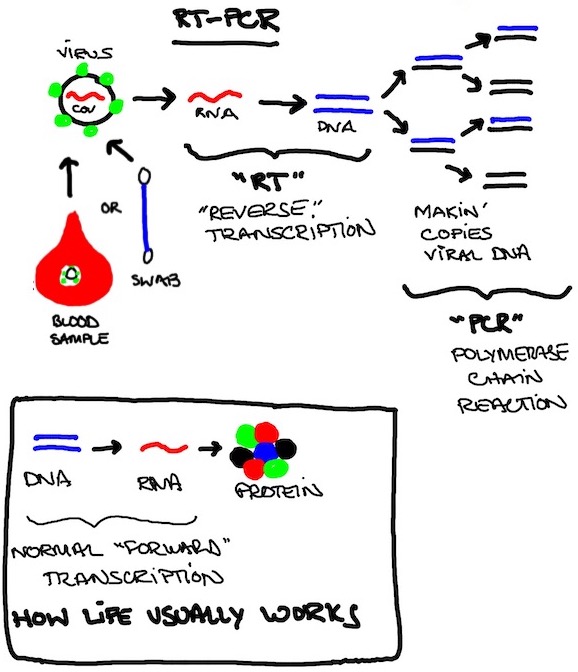
Q. Why even bother with the "RT" part? It just embiggens the acronym.
It's because DNA is stable and much easier to work with, store, amplify, and clone dinosaurs from. RNA is fragile and temperamental. Here today, gone later today. To Arizona St. or the G-League, probably. Too soon?
Worth knowing: RNA's instability means a Coronavirus isn't going to hide out somewhere for months or years or linger after the acute infection is over, like DNA-based viruses e.g. HIV or HSV. If you're RT-PCR positive, there is active virus cranking somewhere in you. Coronaviruses have no "off switch" and this is no long con like The Sting. The standard Coronavirus plan is WE ALL RUSH THE KWIK-E-MART AND GRAB THE BEER AND BREAK A BUNCH OF SHIT AND RUN LIKE HELL CAUSE I THINK I HEAR SIRENS ALREADY.
Digression: PCR was a pretty ingenious setup. The creator, Kary Mullis, won a Nobel Prize for it in 1993. He assigned the patent rights to his employer Cetus, who, ahem, generously gave him a $10,000 bonus, then they turned around and sold those rights for $300,000,000. This message brought to you by CALL ME I'M A PATENT LAWYER.
TEST #2. Abbott "ID Now" Platform
Answers the Q: Am I infected right now?
By looking for: Viral RNA
PRO: Works super fast compared to RT-PCR, supposedly 5-15 minutes instead of many hours (fn6)
CON: Not fully vetted in the field (available under FDA's Emergency Use Authorization, which skips a lot of testing), platform hardware not common in labs like PCR, does one cartridge at a time so throughput doesn't scale easily, initial independent study of accuracy had high false negatives (fn7)
You May Remember Me From Such TV Shows As: COVID Task Force Daily Presser & Shitshow
The platform tech has been around for a minute but the COVID-19 application is new. Abbott is pumping it up and got the aforementioned plug from the White House briefing, but it's not available widely. Still, if they get the kinks worked out, would be a much faster alternative to RT-PCR tests because it doesn't reverse RNA into DNA and never cycles through different temperatures.
Allegedly. Good time to apply marketing hype discount.
How it works: The test kit uses short primers to find the virus RNA and make some quick copies of a sequence from a single gene (fn8). Those copies are lit up with a fluorescent probe and detected by the toaster-sized machine in a fraction of the time it takes for PCR to pile up a detectable amount of DNA.
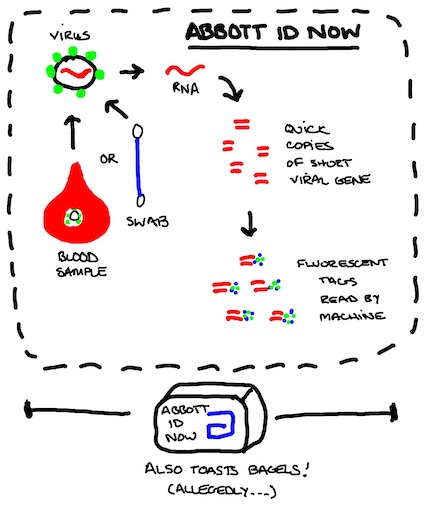
As above with RT-PCR, recall Coronaviruses are RNA viruses, so they're here for a good time, not a long time. If your infection is clear, there are no residual leftovers that show up positive in the Abbott test either.
TEST #3: Antibody Test Type 1 (anti-virus Antibody in Test Kit Seeks Patient's Virus)
Answers the Q: Am I infected now?
By looking for: Intact virions or envelope proteins
PRO: Suitable for a home-based test, well-vetted technology
CON: Not quite as sensitive as PCR assay (some kit manufacturers will disagree) especially early on in infection
Let's make like Katz's Deli and make us some sandwiches. This is a classic assay that you can do in a couple of different ways, but the main principle is:
STEP ONE: immobilize the thing you're looking for with a highly specific (very picky) and high affinity (very sticky) antibody for that thing
STEP TWO: Attach something else to that complex with a signal so you can read it out (a "secondary antibody" that you already know will bind the target and comes with a label of some kind (red dot in the illustration below)
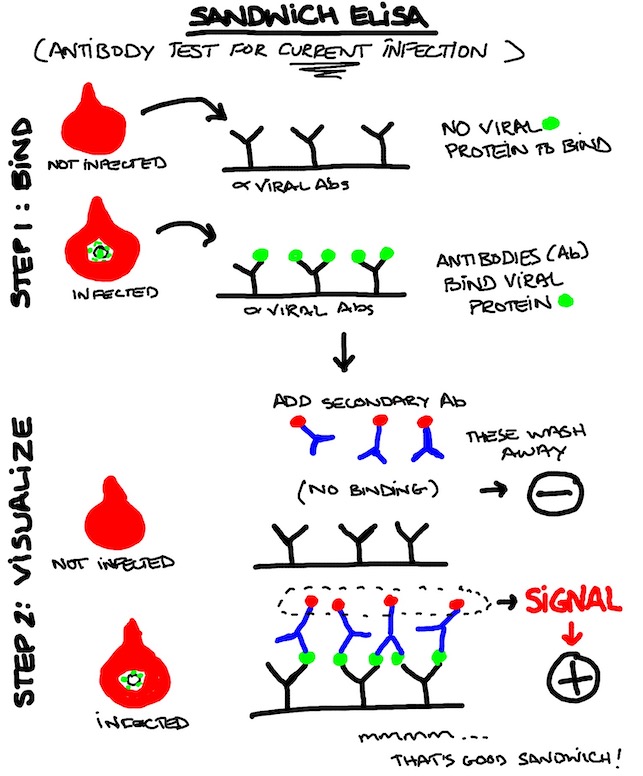
Pretty useful test, and you conceivably do it at home. You might be able to do it without a blood sample at home using a swab, but your swab collecting skills need to be really good and it might be a less user-friendly test for millions of people to perform at home. People who can't put links in MGoBlog posts might not be trusted to perform the protocols 100%. I'm just sayin'.
Take a breath.
Now for the big one.
Now, we get to the thing that is probably going to decide when we get back to "normal" as that term is going to be understood for a while.
So we beat on, boats against the current, borne back ceaselessly into the past, where we may or may not have once been infected by SARS-Cov-2.
TEST #4: Antibody Test Type 2 (Viral Protein in Test Kit Seeks Patient's anti-virus Antibody)
Answers the Question: Was I exposed/infected previously?
By looking for: Antibodies against the virus
PRO: Simple test, can be run at home or in big labs with large throughput of samples
CON: Interpreting the results and drawing conclusions can be... fraught.
I predict almost everyone on this board will be ordering this kit from Amazon to perform at home by the end of the year (or a lot sooner), so you may as well learn how this sucker works.
Basically, the principles here are the same as the ELISA above but you're playing with what stays fixed, and what moves and when. This setup isn't much different than a home pregnancy kit with a couple drops of blood used instead of urine. PRO TIP: You will not get reliable results on your COVID-19 test if you just remove it from the box and take a piss on it.
1. STEP ONE: LOAD BLOOD SAMPLE. Fingerstick and trickle a little blood into the collection area at the bottom of the strip. Add a little buffer and let everything wick through the strip (left to right below). At this point, you have your blood's antibodies (which may or may not be specific for SARS-CoV-2) moving along with a control protein (blue dot) and purified viral protein (green) tagged with a dye (red dot). No, that's not an olive, please stop asking. While you're waiting for the test to work, you may want to take advantage of the blood dripping from your finger.
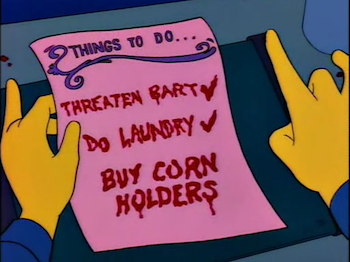
2. STEP TWO: TRAP SPECIFIC ANTIBODIES. anti-SARS-Cov-2 Antibodies (IgM, IgG) will bind to the (green) viral protein and move along with them until they hit the anti-IgM antibody area or the anti-IgG antibody area (yes, antibodies against antibodies are totally a thing). Non-specific (non-picky) antibodies for other things we don't care about will just flow off the end, as will unbound viral proteins if there are no specific antibodies to grab them.
3. STEP THREE: READ THE LINES, NOT BETWEEN THEM. First, you make sure your control line is there, or you throw the strip out. The positive control should work every time because it is independent of the specific antibodies you're looking for, and because the definition of a positive control is that it works every time. THIS IS NOT SEX PANTHER COLOGNE. "60% OF THE TIME IT WORKS EVERY TIME" IS NOT SUFFICIENTLY RIGOROUS FOR VALIDATED TESTING. The dye stuck to the viral protein will aggregate at the lines if specific (anti-SARS-Cov-2) antibody for that protein is present in the blood sample.
NON-INFECTED PERSON (left) INFECTED PERSON (right)
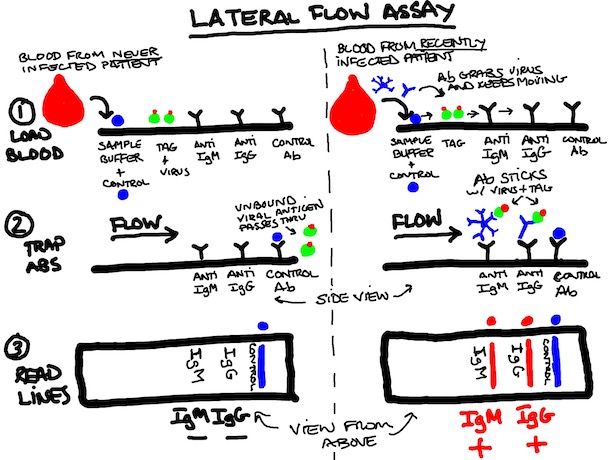

Nice computer animation of the above with a surprisingly excellent electronic soundtrack (they're not searching for antibodies in the sample but principles are entirely the same)(run time 1:53).
Here's a link to a video showing how a test like this would go down for the patient (in this case, it looks like the patient tests negative for both anti-SARS-Cov-2 IgM and IgG)(run time 1:18).
So you end up with a variety of potential results. And things look simple enough... until you try to go from "what is the result?" to "what does this mean in the big picture?"
THE RESULTS, THE RESULTS, THE RESULTS
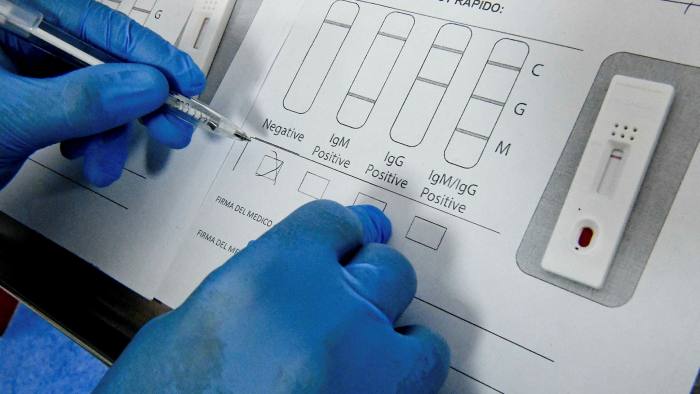
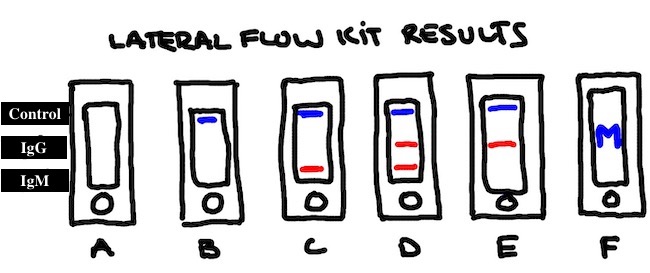
A: No Lines. Your control didn't work, so this one is meaningless.
B: Control only. You have tested negative.
C: Control + IgM. You resolved a past infection quickly (Paul Blart and weird guys to the rescue) or you're in the middle of one right now. You'll probably want to take another test in a week or so.
D: Control + IgM + IgG. You had a full blown infection, and probably recently. Or you have one now. How are you feeling?
E: Control + IgG. If you're feeling well when you took the test, you've probably fended the sucker off. The best case scenario (which we hope but don't know) is that you're not probably not going to get sick again unless a different strain starts a comeback world tour.
F: Block M: Time to source your kit from someone other than Wolverine Devotee.
Pulling everything together at this point seems like a good idea. Yes. Let's.
Chart? Chart. Charts. Two for the price of one. (I’m going to go ahead wager this will not translate well to portrait mode on a phone. Damn the torpedoes)
Chart the First: The Tests (some assembly required)
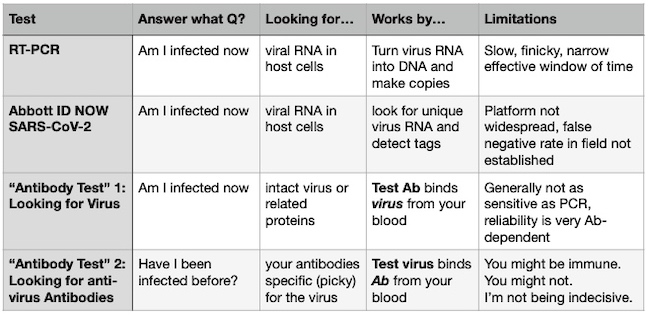
With PCR and ID NOW, recall that you’re probably not going to pick up the virus at the beginning and ends of the infection. With Antibody Test 1 (Looking for Virus), at the end you might be picking up a little more because there is some leftover protein debris from the virus that hasn’t been cleared even though there are no more infectious particles replicating. Remember, RNA disappears fast. Proteins might hang out a little longer.
Also helps to bear in mind this visual reminder from Covid-19 Neck Sharpies Part I of how we're expecting antibodies to come and go. Since we're assuming this is the first time we've seen the virus, the left side of the below graph is the relevant one here:
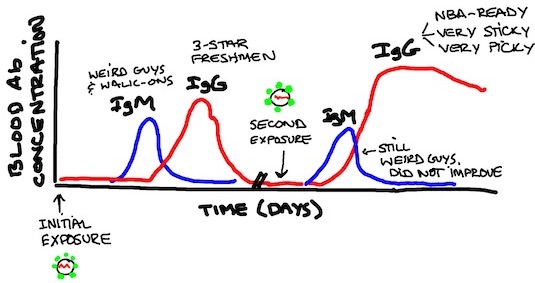
Chart the Second: The Results (some SWAG* required).
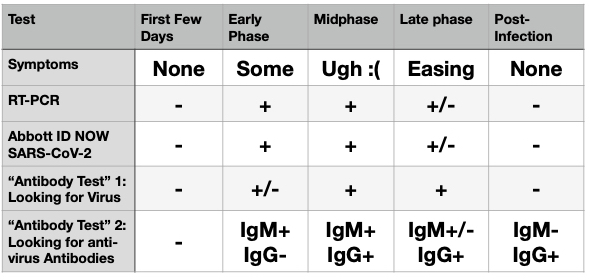
*scientific wild-assed guessing
Q. So, assuming everything worked exactly as we expected (fn9), and I have lots of antibodies, I can pack into The Big House in the fall with 110,000 people who have also tested antibody-positive, and no worries about anything but our untested offensive line and Y NO DEFENSIVE TACKLES?
Yeah, so about that... would you settle for maybe?
NEXT UP IN COVID-19 NECK SHARPIES : PART III. "IMMUNE." YOU KEEP USING THAT WORD.
Earlier I said expect this Monday. By which I meant, don't expect it Monday.
__________
Footnotes
8. See Abbott Labs Covid-19 ID NOW Product Insert (at page 2) LINK TO PDF
9. Yeah, everything working as expected is... maybe optimistic? Coronavirus Antibody Tests: Can You Trust The Results? (New York Time, April 24, 2020)
For the past few weeks, more than 50 scientists have been working diligently to do something that the Food and Drug Administration mostly has not: Verifying that 14 coronavirus antibody tests now on the market actually deliver accurate results.
These tests are crucial to reopening the economy, but public health experts have raised urgent concerns about their quality. The new research, completed just days ago and posted online Friday, confirmed some of those fears: Of the 14 tests, only three delivered consistently reliable results. Even the best had some flaws.
April 27th, 2020 at 10:04 PM ^
you're aces hatter.
and isn't it the strangest thing in the world that my best wishes for you and your family are that you've already had this damned virus?
April 27th, 2020 at 11:35 AM ^
Fantastic stuff, Sopwith—belongs in the MGoBoard HOF.
Since there's no other COVID post on the current board, I'll post this here:
Great post and thanks again for your insights. I'm a Family Med doc and we've bought some of the IgG/IgM kits. I've been using them mostly from a research standpoint and this week will be using quest/lab corp more often We are getting a lot of people calling wanting the antibody testing. So far we have had 4 people turn positive for IgG who had some COVID symptoms and were either PCR neg or didn't have testing done. What are your thoughts on other types of coronavirus infections turning these tests postiive?
April 27th, 2020 at 10:43 PM ^
Great piece
Like the comment “F: Block M: Time to source your kit from someone other than Wolverine Devotee.”
8-0
April 27th, 2020 at 11:38 PM ^
One other question- have you seen data on how many days for IgM and IgG to go positive and for IgM to go negative or does it just depend on the test?
